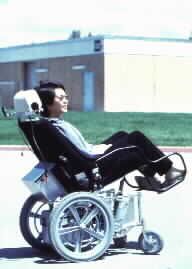 |
Ultrasonic head control
interface
|
 |
Problem:
High level quadriplegics, having lost the use of their arms and legs, require
considerable assistance to accomplish even the simplest mobility or
manipulation task such as turning on a light, typing a letter, moving around
the home, or operating a computer. Since only their head and neck muscles can
still move voluntarily, existing interfaces and switches are often inadequate
in operating continuous-control devices such as electric wheelchairs.
Approach:
The two Polaroid transducers in the ultrasonic head control interface (UHCI)
generate inaudible high-frequency sound waves that propagate through the air
toward the user's head. Energy reflected by the head is detected upon its
return to the transducers. The distance from each transducer to the head is
calculated from the elapsed time between transmission of the sound and the
reception of the echo. Ranging measurements from both transducers allow the
two-dimensional determination of the user's head position.
The user operates the UHCI by tilting his or her head
forward or backward, left or right - movements analogous to manipulating a
joystick. The electronic control signals generated by UHCI from the calculated
head position mimic those produced by a joystick. The signals can be used to
operate a variety of devices including an electric wheelchair, a communication
aid, a video game, or a robotic arm.
The primary advantage of the UHCI is that it requires no
mechanical contact between the transducers and the user's head. The user,
therefore, does not feel "wired up" as with other interfaces that
have components worn on the head or close to the face. By being unobtrusive,
the UHCI is both cosmetically pleasing and socially acceptable.
Specific Technology Transfer Opportunities:
The Rehab R&D Center is prepared to work with a company on a computer
access interface based upon the technologies developed for the Ultrasonic Head
Control Interface. Funding options include those from SBIR proposals or
Cooperative Research and Development Agreement (CRADA). The company should have
experience in microcontroller technology and devices for people with
disabilities. The Rehab R&D Center will contribute its many years of
fabrication, mechanical design, and computer expertise toward a commercial
prototype.
Related Work:
The first application of this ultrasonic ranging technique was as an
interface for electric wheelchairs.
- Investigator:
- David L. Jaffe, MS
|
 |
|
